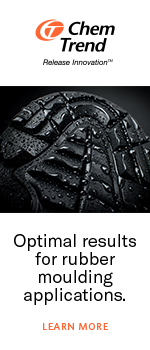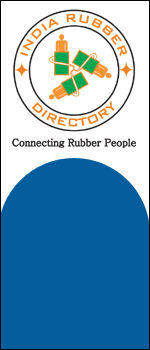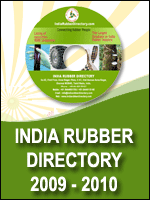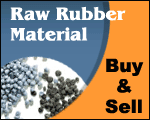Articles - Rubber Technical Papers
DIFFERENT METHODS OF VULCANISATIONG.
Rajammal,
Rubber Technologist
Vulcanisation processes are divided mainly in to two groups.
The first consists of moulding methods which involve an integral shaping
operation which is completed prior to the onset of crosslinking. The second
includes a number of techniques used to cure a previously formed product.
During vulcanisation, externally supplied heat flows in to the rubber at
a rate controlled by efficiency transfer properties of the rubber. Changes
in temperature within a rubber product tend to give a non-uniform state
of cure and result in the properties of rubber at the surface of a product
being quite different from those at the centre. One of the main objectives
of selection and optimisation of vulcanisation processes is for achieving
a uniform state of cure with viable production rate.
Vulcanisation like all chemical reactions naturally gets faster as the
temperature rises. The velocity of reaction is approximately doubled or
the reaction time is approximately doubled or the reaction time is approximately
halved for every 8 - 10°C by which the temperature is raised. For
the purpose of streamlining operations, it is of course very desirable
to use the highest possible vulcanisationo temperatures in order that
correspondingly short vulcanisation times may be employed. However, the
extent to which this can be done is limited for various reasons. For example,
compounds with a very broad vulcanisation plateau permit high vulcanisation
temperature, the opposite is true of compounds with a narrow plateau.
The greater, the thermal stability of the rubber, the higher the vulcanisation
temperature which can be tolerated by the material without its properties
suffering. As the mechanical properties of vulcanisates depend on the
vulcanisation temperature, in some special case, there will be a temperature
limit, which should not be exceeded.
Often when the articles are vulcanised in a press and definite dimenstios
have to be adhered to with definite moulds, the vulcanisation temperature
cannot be changed because a different temperature would lead to a different
degree of shrinkage. Where vulcanisation in hot aire is concerned, the
upward temperature limit is fixed by the oxidising action of the oxygen
present. Only in certain cases, therefore, can the vulcanisation temperature
be raised to such an extent that extremely short vulcanisation times can
be used. One of these cases is the continuous vulcanisation method.
I. Vulcanisation in a Press (Moulding methods)
Vulcanisation in a press involves the transfer of heat from the metal
of the mould to the article to be vulcanised. This subject is dealt in
detail in the chapter, "Different methods of moulding".
II. Vulcanisation by methods other than moulding
It is convenient to group these vulcanisation methods in to two:
1. Batch curing methods in which one batch of material or components
is cured at a time and
2. Continuous vulcanisation methods which involves continuous vulcanisation
of lengths of material.
II. 1. Batch Curing methods
II. 1.1 Autoclave or steam pan
The autoclave is used for the vulcanisation of extrusions, sheeting
and components that are of an unsuitable size for convenient mould curing.
Examples of these compoments are rollers and hand formed goods. It is
also used for the secondary vulcanisation of large moldings to improve
press and mould utilisation. The temperature and pressure required for
cure are achieved by the use of steam.
As autoclave is a cylindrical pressure vessel, normally used in the
horizontal position. Autoclaves can be of two main types:
1. A jacketed autoclave consists of two large pressure vessels, one inside
the other,
Constructed, so that it is possible to fill the inner vessel with an inert
atmosphere, such as nitrogen (to prevent polymer degradation through oxidation)
and the outer vessel with high-pressure steam to act as the heating medium.
The inert gas eliminates oxidation and permits brightly coloured articles
with a good surface finish to be produced. It is also referred to as 'gas
curing'
2. An unjacketed autoclave consists of a single cylindrical pressure
vessel. Steam
Is introduced directly in to the autoclave and may cause condensation
marking on the product. Preventive measurers usually result in a dull
surface finish.
One of the advantages of an autoclave is that a large number of components
can be vulcanised at one time, provided that the curatives used in different
materials do not interact. It is usual to support the extrusions and small
components by embedding them in talc on trays. Products formed on mandrels
and sheeting are cloth wrapped. To prevent distortion. In some instances
clamped up mandrels are used.
After loading the autoclave with the components, it is closed. Steam
is then very rapidly applied and th e vulcanisation completed for the
prescribed cycle. The pan is then cooled while soill under pressure, otherwise
blistering of the product may occur. Bulky components usually require
a "stepped cure" which involves raising the auto clave temperature
to the maximum vulcanisation temperature through a series of steps to
give a relatively uniform temperature distribution through the product
during heating. This technique is used when bulky mouldings are given
a second cure in the autoclave after being vulcanised to the point of
dimensional stability in the mould.
Autoclaves are pressure vessels and need to comply with the general
regulation for pressure vessels which require regular testing and fool
proof interlock mechanisms to prevent the door from being opened while
there is a pressure in the autoclave. Even very low pressures can exert
considerable forces over the door area.
II.1.2. Hot Air Ovens
The majority of rubber compounds, if heated at atmospheric pressure
sponge as a result of dissolved air and moisture or degrade owing to oxidation.
Ovencuring, is not, therefore, generally applicable as a curing procedure.
It is however possible in the case of certain heat resistant polymers
eg: silicone and fluorocarbon rubbers for post curing. The hot air post
cure serves two purposes.
1. The first is to continue the crosslinking process to improve the physical
properties of the rubber product.
2. The second is to drive off volatile materials from components intended
for service at high temperature by raising them above their service temperature.
Potentially, toxic fumes are disposed of in this way and hence it is important
to vent the oven directly to the atmosphere and to ensure that fumes do
not re-enter any of the work areas.
The ovens require precise temperature control varying from ±5°C
to ±1°C.
II. 1.3. Water Curing
Water curing techniques usually employ an autoclave as a pressure vessel,
heating being either from a steam jacked or from steam injection. The
autoclave is first loaded with the components, then filled with cold water
and steam is then applied and vulcanisation is completed for the prescribed
period. This method curing finds application in the vulcanisation of very
large hand build rubber lined machinery such as pumps, pipes and chemical
tanks. The water supplies the pressure for adequate adhesion of the rubber
to metal in addition to acting as the heat transfer medium.
II. 1.4. Lead curing
Moulded length hose is cured by this technique. It involves the formation
of a lead sheath around the hose. The sheath of lead is made to surround
the cover of the hose by passing through a lead is made to surround the
cover of the hose by passing through a lead press or a lead extruder.
The lead-sheathed hose is next wound on to a large drum. The lining of
the hose is now filled with water, pressure applied and the ends of the
hose and leads are clamped. The drum and contents are placed in large
vulcanising pans (steam autoclaves) and curing is carried out. The water
inside the hose expands and becomes superheated.
The hose is pressed against the lead which not as a mould and hence
the name of the process. If the inside of the lead is fluted, then such
a finish is imparted on to the hose. If smooth dies are used to form the
lead, then of course, a smooth finish is produced. After cure and cooling,
the clamps are out from the hose by slitting along its length in a stripping
machine. The cured hose is coiled up, tested and inspected and the scrap
load is returned to the melting pot for reuse.
II.1.5. Cold Curing
Thin rubber products can be vulcanised by immersion in a carbon disulphide
solution of sulphur chloride or by exposure to its vapour.
II.2. Continuous Vulcanisation
II.2.1. High pressure steam tube
In steam tube vulcanisation (often called the cv process), the extradite
is unsupported and is subjected to tensions which could cause total failure
of a homogenous extradite. For this reason, the technique is only suitable
for composite products having a continuous non-rubber reinforcement which
remains relatively inextensible at the vulcanisation temperature. This
finds two major applications viz., in cables and hoses.
When cable is covered with rubber, the wire core provides a means of
drawing the rubber cable. The cable passes from the extruder in to the
steel tube which high temperature and high-pressure steam (15kg/cm²
or higher). Vulcanisation takes place in this tube. This tube, approximately,
75cm. Long is sealed to the extruder at one end and the other end is sealed
with rubber or waterseals to retain the steam pressure. The length of
the tube and hence the cure is determined by the line speed of the cable
together with the pressure and temperature of the steam in it. The cable
passes through a series of mechanical seals or a pressurised water seal
to atmosphere. Three types of steam tube are used, inclined, catenary
and vertical. The choice between them is determined by the tension needed
to hold the product away from the tube wall. The average length of a vertical
tube is 50 m. compared with 60 m. for the inclined tube and 100m. for
the catenary tube.
II.2.2. Hot Air Tunnel
It is possible to use a single gas heated tunnel for the vulcanisation
of cellular extrusions and carpet underlay, which do not have to meet
tight dimensional tolerances.
The method is very cheap to run, particularly, if several extrusions
are traversing together, but the cost of installation of this type of
tunnel is very high. Hot air tunnels usually electrically heated are used
for the vulcanisation of silicone rubber products, in which case the exit
temperature is 250-300°C.
II.2.3 Fluidised Bed
The principle upon which the Fluidised bed operates if the floation of
particles of an inert material such as sand or very small glass balls
(ballotini) in an air stream, giving fluidity to the system. Two types
of fluidised beds are available, one of which operates at atmospheric
pressure and one which operates at pressures upto approximately 0.7 Mpa.
The former type is used for homogenous or reinforced extradites, whereas
the latter has been developed specifically for cable and hose.
Fluidi sed beds are on line vulcanisation processes designed to accept
a product direct from the extruder. The vulcanisation chamber or troug
contions a bed of heated fludised particles, through which continuous
extruded rubber sections, may be easily passed without resistance. The
bed of particles of ballotini, a sand like materials is heated initially
by steam and once the operating temperature has been obtained, air is
substituted for steam and the heating is continued electrically. This
causes the particles to become suspended on thesteam/air stream and separated
from each other. In this state, the bed takes on all the attributes of
a liquid, objects can float on the surface of the bed or sink depending
on their density and convection currents can be set up in the bed. Thus
externally applied heating will be transferred to objects in the bed by
convection heat transfer. The bed provides support also to the extrudate,
thus ensuring minimal distortion. The product to be vulcanised floats
near the surface of the bed and cure takes place in a short time. The
cure time of a fluidised bed extrudate is a function bed length and have-through
speed. Operating temperature upto 240°C may obtained. The length of
the bed and temperature can be varied to suit specific manufacturing conditions.
To prevent porosity of the compounds, when vulcanised at high temperatures,
desiccants (caloxol) may be added in the compound during mixing.
As for any vulcanisation, venting of fumes is essential and most fluidised
beds are enclosed ensuring that all the fumes generated are drawn off
and vented to the atms. The fluidised bed cheap, used for many types,
and efficient for long runs.
II.2.4. Molten Salt Bath (Liquid Curing Method)
In principle this method is applicable to solid and cellular extrusion.
Molten salt batch an cutectic mixture of inorganic salts, usually potassium
nitrate and sodium, nitrate, at a temperature of 150-250°C. Salt baths
are very similar in external forms and arrangements to the fluidised bed.
However, the salts are much denser than rubber compounds requiring the
use of rollers or a submerged conveyor belt to hold the extrudate under
the surface of the molten salt. Furthermore, the density of the salts
obviates the necessity for the use of the desiceant necessary with fluidised
bed. Any salt adhering to the extrusion is removed by means of a water
wash tank.
II.2.5. Microwave curing
Microwave curing has the advantage of providing uniform and rapid heating
Throughout a product. The majority of microwave units are designed to
accept extrudates, but they are also used to preheat conveyor belting
prior to press vulcanisation and drum. Vulcanisation. In the hose in the
hose industry, its use is limited for curing of only non-metallic hoses
because of the metallic interference.
Microwave vulcanisation units consist of a microwave section followed
by a hot air section, the function of the latter section is to maintain
the temperature established by microwave heating. The whole system is
about 7 m. in length and a conveyor belt mode from materials not susceptible
to microwave heating is used to transport the extrudate through it.
In this connection, microwave curing is neither better nor worse than
LCM and fluidised bed techniques. The system is more clean, heating is
more uniform and do not require the latter cleansing operations of either
the LCM and fluidised bed techniques.
Non-polar rubbers such as NR, SBR and EPDM are poor absorbers of microwaves
and becomes only viable propositions for microwave vulcanization when
mixed with carbon black or with a polar polymer such as NBR or PVC. Two
further problems are dimensional stability and oxidation. During vulcanisation,
the extrudate is unsupported and can destroy after heat softening, simply
by the effect of itsown weight and it will then be vulcanised in the distorted
shape. Surface oxidation may occur with NR and SBR due to the high temperature,
although modern antioxidants provide sufficient fume extraction system
is required and microwave emission levels are to be monitored at regular
intervals.
II.2.6. Continuous Drum Cure
Continuous Drum Cure is used for the vulcanisation of sheet material,
flooring and belting. It is an offline process due to the through put
rate being much lower then that of calendering or spreading, Two machines
in common use are the Berst off and Roto Cure.
The sheated material is fed between a large heated curing drum and a
tension steel belt which holds the sheet around the circumference of the
drum. And imparts a good surface finish to the product. On emergence,
it is fully cured. The speed of rotation of the curing drum is variable
and is adjusted to achieve the full vulcanisation of the material in the
time of its passage through the machine.


























